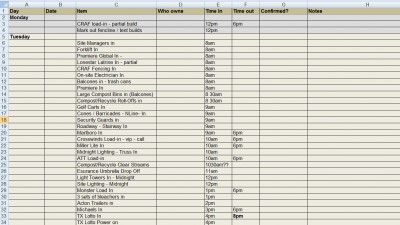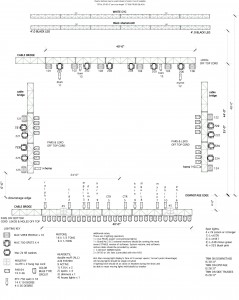Production Guide
Production management in the event and festival industries can mean virtually everything related to the execution of the event or, for larger events, it can mean anything involving the primary entertainment and related needs – be it music, comedy, film, or culinary (as examples). Below is an overview of everything the production team is involved with and various templates and forms to help keep everything organized.
- Overview of the Production World
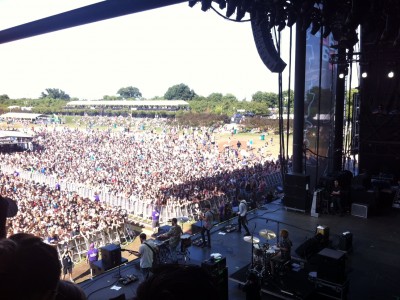
Lollapalooza 2013
- What the Production Department / Team handles in a general sense
- Anything related to the production of the primary entertainment of a festival – the sound, lighting, staging, video, backline, equipment, power, and all related labor.
- What to expect, production-wise, given the scope of your event
- For smaller events, this can mean a simple PA (live sound) setup with a stage and a few stage lights. Often audio vendors will have enough inventory to cover the entirety of a small event’s needs with a simple PA, stage, lighting, and backline.
- For larger events, this can mean multiple stages with their own PA systems and stage lighting; generators spread throughout to provide ample stage power; loading docks for semis and box trucks; day and night staff to work around the clock.
- What the Production Department / Team handles in a general sense
- Audio (view separate Audio Guide for more in depth information)
- Here are the basic concepts / elements of sound reinforcement for events and festivals:
- Decibels and sound pressure – decibels are the standard for measuring loudness because it is logarithmic, so smaller numbers can be used to express values that otherwise would require many more digits. Secondly, our hearing is also logarithmic, providing a solid relationship for judgment.
- The PA System – short for “public address” system, this normally stands for any sort of live audio reinforcement system, to project sound to an audience. Usually the main PA system console is set up approximately double the width of the stage dead center in the crowd. So if the stage is 40′ wide, ideally, the main console – also called the Front of House console – would be set up 80′ from the downstage edge, aligned to the center of the stage.
- Monitor System – in medium to larger applications, there can be a separate audio system that handles all of the audio needs for the musicians themselves – what comes out of their monitors so they can hear not only themselves but their band mates. Usually the monitor system console is set up on the side of the stage.
- Microphones – an essential element in virtually every sound application, microphones pickup sound waves in a few different ways – omnidirectional, bidirectional, and cardioid (more details on these types are in our Audio Guide).
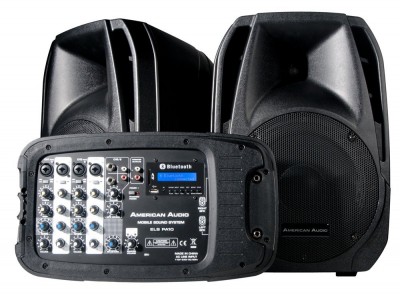 What sort of audio needs will your event have? Depending on the size of your event, you could get by with a minuscule two speaker and a mixer setup like this one or you may need upwards of 40+ speakers to reach a crowd in the tens of thousands. What helps you determine your needs will includes factors such as expected attendance, sound ordinance restrictions, artist audio requirements, and the overall theme of your event (is it a music-focused festival or is the music more subdued, background noise to compliment other elements?).
What sort of audio needs will your event have? Depending on the size of your event, you could get by with a minuscule two speaker and a mixer setup like this one or you may need upwards of 40+ speakers to reach a crowd in the tens of thousands. What helps you determine your needs will includes factors such as expected attendance, sound ordinance restrictions, artist audio requirements, and the overall theme of your event (is it a music-focused festival or is the music more subdued, background noise to compliment other elements?).
- Here are the basic concepts / elements of sound reinforcement for events and festivals:
- Lighting (view separate Lighting Guide for more in depth information)
- Here are the basic concepts of stage / concert lighting (all photos courtesy of Ilios Lighting):
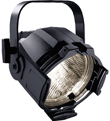 PAR Cans – parabolic aluminized reflector light is a sealed beam lamp (like a car headlight), and the housing (including the lamp, color gel, and any external hardware) is called a PAR Can. These lights are very common for indoor and outdoor stage lighting, but have recently become less popular due to the advent of LED lighting that can accomplish virtually the same task with a fraction of the power consumption.
PAR Cans – parabolic aluminized reflector light is a sealed beam lamp (like a car headlight), and the housing (including the lamp, color gel, and any external hardware) is called a PAR Can. These lights are very common for indoor and outdoor stage lighting, but have recently become less popular due to the advent of LED lighting that can accomplish virtually the same task with a fraction of the power consumption. 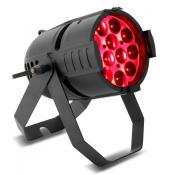 LED Lighting – becoming more common as the available color spectrum, luminosity, and versatility of these new kinds of lights grow. Many artists are replacing their conventional PAR Cans with LED Cans to save on power needs as well as the added safety of not having blistering hot lamps (LEDs run cool).
LED Lighting – becoming more common as the available color spectrum, luminosity, and versatility of these new kinds of lights grow. Many artists are replacing their conventional PAR Cans with LED Cans to save on power needs as well as the added safety of not having blistering hot lamps (LEDs run cool). 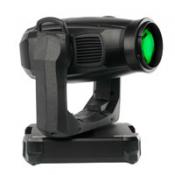 Moving / Intelligent lighting – virtually every mid to large scale stage production will have these kinds of lights, which offer a wide variety of attributes to refine movement, control iris size, change gobos, and mix in different colors and patterns. They often come with a fixture body wrapped in an automated, programmable yoke.
Moving / Intelligent lighting – virtually every mid to large scale stage production will have these kinds of lights, which offer a wide variety of attributes to refine movement, control iris size, change gobos, and mix in different colors and patterns. They often come with a fixture body wrapped in an automated, programmable yoke. 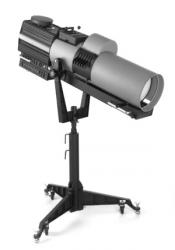 Follow spots – also called spotlights, these are large lights that provide focus and/or highlight a performer or an area of the stage. For larger events, many artist will require anywhere from 2 to 8 follow spots to compliment their onstage lighting.
Follow spots – also called spotlights, these are large lights that provide focus and/or highlight a performer or an area of the stage. For larger events, many artist will require anywhere from 2 to 8 follow spots to compliment their onstage lighting.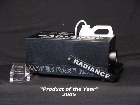 Hazers and foggers – machines used to create atmospheric effects and to allow beams of light to be seen more intensely. They are either droplet generators or particulate generators, which disperse fine droplets of oil or a water mix to catch, reflect, or diffract any light that comes into contact with it. For indoor events, you must make sure to understand the fire alarm system as many newer systems are sensitive enough to be set off by these machines. Many indoor venues will require a Fire Watch – paying a local Fire Marshall to observe the event and place the fire alarm on bypass mode – for the duration of your event to keep in line with fire safety regulations.
Hazers and foggers – machines used to create atmospheric effects and to allow beams of light to be seen more intensely. They are either droplet generators or particulate generators, which disperse fine droplets of oil or a water mix to catch, reflect, or diffract any light that comes into contact with it. For indoor events, you must make sure to understand the fire alarm system as many newer systems are sensitive enough to be set off by these machines. Many indoor venues will require a Fire Watch – paying a local Fire Marshall to observe the event and place the fire alarm on bypass mode – for the duration of your event to keep in line with fire safety regulations.
- Given your event size, your stage lighting may be as simple as a few par cans at the front and back of the stage to provide a general lighting wash for the performers. Most small to medium size stages have x12 to x24 LED or Conventional fixtures upstage and downstage, along with a few moving lights for effect. Larger stages can require massive amounts of moving lights along with follow spots.
- Here are the basic concepts of stage / concert lighting (all photos courtesy of Ilios Lighting):
- Video (view separate Video Guide for more in depth information)
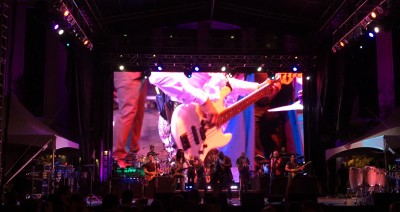
40′ wide LED Wall upstage center running live iMAG for a concert
- Here are the basic concepts of video projection and LED video walls:
- When your event should have video? The factors include:
- Size of audience – will there be enough people to make the video worthwhile?
- Artist requirements – do they require LED walls or projections as part of their performance?
- Time of day (too bright out? Can’t / won’t pay for video bright enough for daylight?)
- If the event is being archived / streamed live – if there is already a video crew for the artist, it may make sense to provide video walls and request a feed from the artist
- When your event should have video? The factors include:
- What sort of video production level makes sense given various event sizes?
- For smaller events, a 2-3 camera shoot is normally acceptable. Ideally there would be a fixed camera at Front of House for the wide angle shot, and then 1-2 close up handheld cameras either on-stage or in the bit.
- For larger events, you can add multiple cameras at FOH, cameras off to the side to capture different angles, and/or cameras placed in the crowd (usually on a jib).
- Here are the basic concepts of video projection and LED video walls:
- Backline (view separate Backline Guide for more in depth information)
- Backline – the gear bands request in order to play – is essential to every performance. Depending on the event, it may be better to utilize shared backline instead of having bands bring their own gear.
- Usually festivals with short change over times (under 30 minutes) will benefit greatly from having the bands share backline, at least the drum kit. That will help keep things on time.
- How to best organize / advance backline needs
- Communicate with each band and see what they can share, taking into account what sort of contract they signed (they may have no choice). Ensure everyone knows what they need to bring vs. what will be provided for them and provide the artists with a breakdown of the gear from the backline company.
- Backline – the gear bands request in order to play – is essential to every performance. Depending on the event, it may be better to utilize shared backline instead of having bands bring their own gear.
- Staging (view separate Staging Guide for more in depth information)
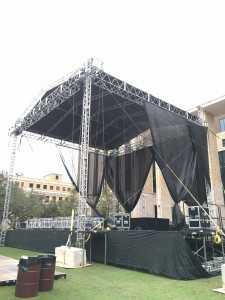
Tomcat 44×44 Steel Truss Stage
- Basic concepts of outdoor staging
- Most events utilize bil-jax or StageRight type decking as it they typically satisfy any permit needs and they are very versatile / reliable. Most stages are built in 4’x4′ or 4’x8′ increments, but 3’x6′ can also be used.
- Mobile stages and steel stages
- Mobile stages are becoming more and more common due to better design and higher wind ratings as compared to TomCat / steel truss stages. But steel staging is still very popular and fits well in many event and festival applications.
- Wind / Lighting ratings / planning for inclement weather
- You will want to check with your local fire marshall / city officials and see what sort of wind rating your stage needs to have to meet all local laws – some are as high as 90 mph.
- Having a proper inclement weather plan is essential. You will want to establish a chain of command, a group of decision makers, and parameters for certain action (such as, delaying the event, evacuation, full cancellation). You will want to take into consideration a lighting strike radius and sustained wind speeds. Look for our weather plan template coming soon, but in the meantime The Event Safety Guide has a lot of great information on this topic.
- ADA Needs – you will want to ensure that your stage is ADA accessible if needed; often this isn’t a requirement unless the band requests it, but many larger events build ADA platforms near FOH to accommodate ADA patrons.
- Basic concepts of outdoor staging
- Power Needs for Stage
- Advancing the proper power needs for all stage related vendors, including lighting, audio, video, backline, and the artist themselves.
- Finding the best place for the generators, distro, and breaker boxes – you will want to ensure that there’s enough distance between the generators and the stage; usually 100′ or so works best with most vendors’ cable lengths.
- Visit our Electricity Guide for more details on power terms.
- Barricade for Stage
- Using mojo / flow-through barricade instead of bike rack – when and where it makes sense
- Understand the type of crowd that is coming and the size of that crowd; for older crowds, bike rack may be sufficient; for younger or larger crowds, having a steel or aluminum flow-through barricade that actually gets stronger when people lean on it is all but a necessity (and often required in larger band contracts).
- Using mojo / flow-through barricade instead of bike rack – when and where it makes sense
- Rigging
- Larger events will require skilled personnel who have been certified to climb up in either the ceiling, the roof, or the custom-built truss structure in order to properly hang points that will eventually hoist up audio gear, lighting gear, more truss, LED walls, backdrops, curtains, or anything else that needs to be suspended from the air.
- Coming soon – example of a rigging plot and descriptions of 1-ton / 2-ton motors, pounds per square inch, other weight concerns.
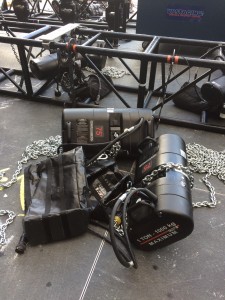
- Special Effects – Pyro / Cryo / Confetti
- Some artists will elect to utilize special effects during their performance; the three main types of effects are:
- Pyro – short for pyrotechnics, this involves any sort of device or fixture that emits various kinds fireworks. These will almost always require fire marshalls on hand not only during the performance, but for any rehearsals as well. The pyro vendor will also need to provide you with all permits, personnel information, and fire safety information related to the devices they’re using.
- Cryo – short for cryogentic, these effects create a burst of intense fog as a result of utilizing liquid carbon dioxide tanks.
- Confetti – often utilized in cannons, artists will often trigger the cannons to emit a burst of confetti at specific times during their performance. You’ll want to make sure it’s biodegradable confetti if possible and you’ll want to make sure you plan for any extra cleanup that will result.
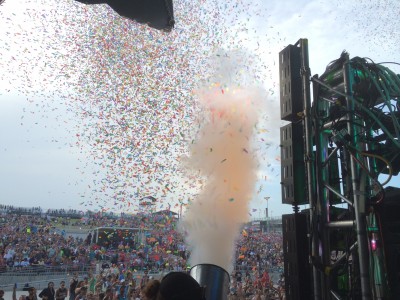
- Some artists will elect to utilize special effects during their performance; the three main types of effects are:
- Tying in with the Artists
- A team of people including a stage manager, production manager, venue rep, promoter rep, tour manager, hospitality manager, artist relations manager and office manager all work together with the artist at various levels of scope. For smaller events, many of these roles can be combined. View our Stage Manager Guide for more information.
- Any ALD (assisted listening device) / sign language interpreting for the hearing impaired?
- What is the venue / event’s policy if someone requests an interpreter? Policies vary per event but normally if someone requests ALD up to 72 hours prior to the event, it is standard to provide it.
- Where do you place them, and will they need to be lit from FOH? Normally you will place them in the pit off to the side, and you’ll have a light either from the stage or from FOH to properly light them.
- Hiring the Proper Labor – Union / Non-Union
- How to properly staff given your local and state requirements – you’ll want to understand if you’re in a right to work or union state. The venue you chose to work in may also have requirements as well.
- For more information, visit our Labor and Staffing Guide that includes examples of labor grids, the primary unions in our industry, how to properly plan for meals, and much more.
- The On-Site Production Office Needs:
- For outdoor events, many production companies will utilize mobile offices that are usually 10×44 or 12×56 with one large room in the middle and two smaller offices on either side. There are a lot of floorplan options and several companies that can provide these kinds of offices.
- The Office Manager – What they do for the Production World:
- Distribute credentials for production staff and vendors
- Oversee catering and meal needs for staff and vendors
- Organize and manage all production (and sometimes, site and/or artist) ground transportation and the runners hired to drive the vehicles
- For smaller events, may also oversee two way radio and/or golf cart distribution
- Help out with printing and signage needs
- Order production items
- Items needed most by production teams
- Gaff tape, zip ties, and plastic sheeting are just a few of the items most events will need. View our Event Expendables Guide for a list of most needed items with quick links to purchase from Amazon.
- When to set up / strike, ideal placement:
- Ideally you want to have the office set up a full day before the production team starts the build, so everything office-wise is up and running first thing that morning. You want to be tucked out of the way of the event, but close enough for easy access when needed.
- Production Runners / Transpo Management
- Most events will need a dedicated runner that can leave at a moment’s notice and pick up essential items as demand dictates. These runners must not only be familiar with the area, but they also much be skilled at finding the items quickly and getting back to site. Some runners can use their personal vehicles, but for larger events / needs, often a 12 or 15 passenger van is rented for them.
- More information on runners, including a running grid template, can be found at our Talent Buying and Artist Relations guide.
- Bringing it all Together
- The Production Timeline is the master document that keeps everyone on task – it should list every important element, who’s responsible for it, and what time it’s happening.
- For an example of a Production Timeline to use for your own event, download the .xlsx version here
